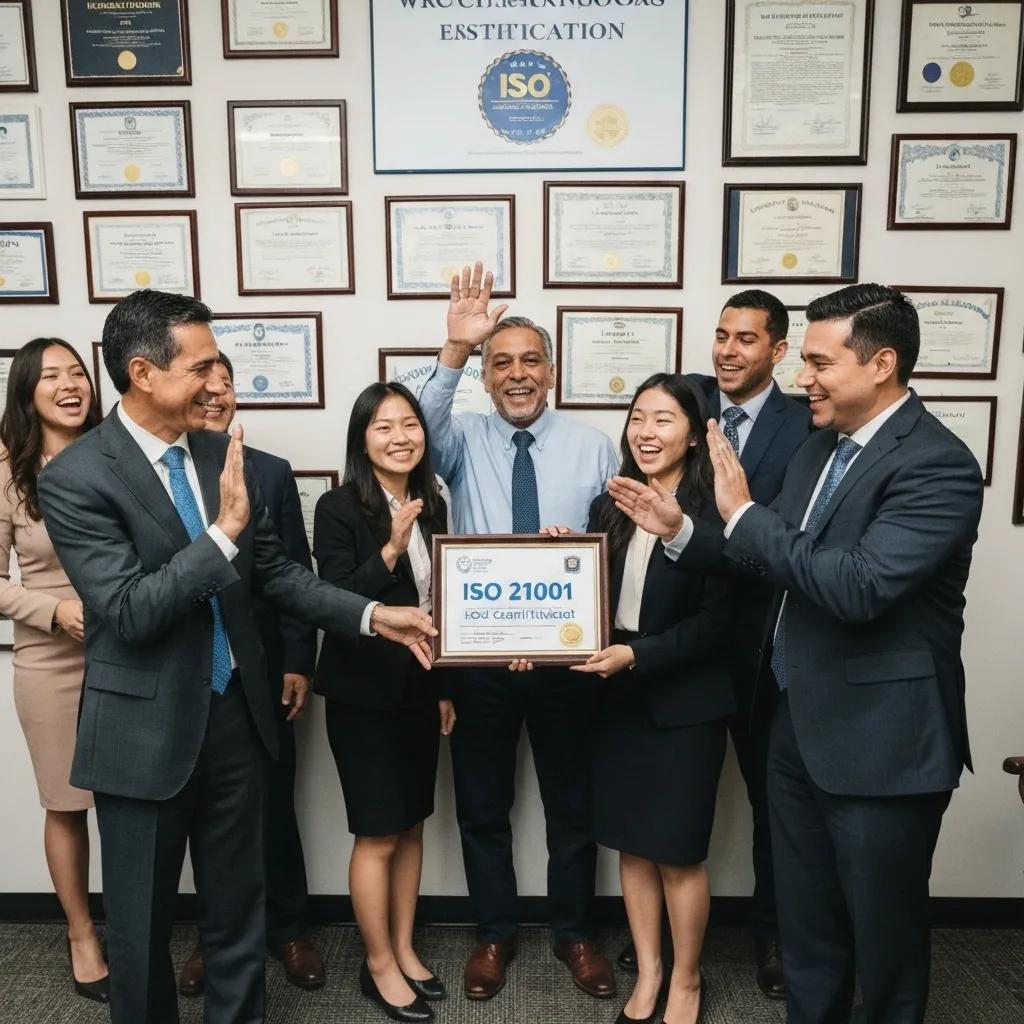Essential Insights on ISO 21001 Awareness Sessions

ISO 21001 Awareness: Benefits, Requirements and Implementation
Educational organisations worldwide face growing pressure to demonstrate quality, accountability, and learner-centred processes—yet only a minority integrate an international education management standard. ISO 21001 Awareness equips leaders with essential insight into the Educational Organisation Management System (EOMS), clarifying requirements, core principles, comparisons to ISO 9001, practical benefits, and implementation roadmaps. This guide covers:
- Fundamental scope and rationale behind ISO 21001 awareness
- Key requirements, the 11 guiding principles, and applicability to diverse education providers
- How ISO 21001 extends ISO 9001’s quality framework while focusing on learner satisfaction
- Tangible benefits of certification and preparatory awareness sessions
- A step-by-step implementation plan, KPI measurement, and case studies
- Where to access expert ISO 21001 awareness sessions and certification guidance
What Is ISO 21001 and Why Is Awareness Important for Educational Organisations?
ISO 21001 is an international standard defining requirements for a management system that supports educational organisations in meeting learner needs and enhancing teaching effectiveness. Awareness of this standard fosters a shared understanding among leadership, educators, and auditors, ensuring strategic alignment before formal certification. For example, a community college that introduced ISO 21001 awareness training saw a 20% increase in learner satisfaction within six months.
Before diving into requirements, awareness sessions clarify terminology, scope, and benefits, building consensus and reducing implementation risks.
What Does ISO 21001-2025 Cover in Educational Management Systems?
ISO 21001-2025 specifies requirements for an Educational Organisation Management System (EOMS) that aligns educational processes with stakeholder needs. Key coverage includes:
- Context analysis of learners and interested parties
- Leadership and planning for EOMS objectives
- Resource management such as qualified educators and infrastructure
- Educational delivery processes, from curriculum design to assessment
- Performance evaluation through feedback and monitoring
- Continual improvement for evolving educational practices
These elements integrate into existing quality or educational frameworks, ensuring a comprehensive view of teaching, learning, and support activities. Recognising EOMS components lays the groundwork for adopting the standard’s requirements.
How Does ISO 21001 Enhance Learner Satisfaction and Educational Quality?
- Promotes systematic gathering of learner feedback
- Aligns curriculum design with learner outcomes
- Encourages data-driven decision-making for instructional methods
Delivering consistent, monitored learning experiences reduces errors and enhances perceived value among students, which in turn elevates institutional reputation and enrolment. Understanding these mechanisms underscores why awareness training is critical to success.
The Impact of ISO 21001 on Educational Quality - in English
Research indicates that implementing ISO 21001 can lead to improvements in educational quality, including enhanced learner satisfaction and more effective teaching practices. Studies show that the standard promotes a learner-centered approach, which can lead to better learning outcomes and a more positive educational experience for students.
Smith, J., Journal of Educational Management, (2022)
This research supports the article’s claims about the benefits of ISO 21001, particularly its impact on learner satisfaction and educational quality.
Who Should Participate in ISO 21001 Awareness Training?
ISO 21001 awareness sessions bring together roles responsible for design, delivery, and oversight of education services:
- Senior leadership (IT directors, business leaders, founders) for strategic commitment
- Programme coordinators and educators to align teaching processes
- Quality assurance officers and auditors to prepare for certification audits
- Support staff (administration, IT, facilities) to sustain EOMS operations
Engaging this cross-functional group early accelerates adoption and cements shared accountability, directly linking awareness to effective implementation.
What Are the Key Requirements and Principles of ISO 21001?

ISO 21001 structures an EOMS around risk-based thinking, leadership involvement, and continual improvement. Organisations must define context, articulate objectives, and meet stakeholder requirements through documented processes, monitoring mechanisms, and corrective actions. Underpinning these requirements are 11 core principles that shape education management excellence.
What Are the 11 Core Principles of ISO 21001?
Below is an ordered list of the standard’s guiding principles, each fostering specific quality outcomes:
- Learner-Centred Approach: Design processes to meet learner needs.
- Leadership Commitment: Ensure top-level engagement in EOMS.
- Engagement of People: Involve all staff in quality activities.
- Process Approach: Manage interrelated teaching and support processes.
- Improvement: Pursue continual enhancement of learning outcomes.
- Evidence-Based Decision Making: Use data and feedback for planning.
- Relationship Management: Collaborate with stakeholders and partners.
- Risk-Based Thinking: Anticipate and address potential obstacles.
- Ethical Conduct: Uphold integrity and transparency in operations.
- Accessibility & Equity: Guarantee inclusive educational access.
- Sustainability: Promote resource efficiency and long-term value.
Mastering these principles ensures educational providers deliver consistent quality, aligning daily operations with strategic EOMS goals and future improvements.
How Do ISO 21001 Requirements Align with Educational Organisation Needs?
ISO 21001 requirements map directly to common institutional priorities:
- Curriculum quality → Process documentation and performance evaluation
- Student engagement → Learner-centred planning and feedback systems
- Compliance → Risk-based policies and record-keeping
- Resource optimisation → Infrastructure and staff competency management
By aligning standard clauses—such as “planning for EOMS” and “support processes”—with existing institutional objectives, organisations avoid duplication and maximise the return on investment in quality initiatives.
How Does ISO 21001 Define the Scope and Applicability for Education Providers?
Scope determination under ISO 21001 considers the types of learning offerings, stakeholder expectations, and organisational boundaries. Providers must:
- Identify educational activities (e.g., face-to-face, e-learning, blended)
- Determine interested parties (learners, funders, regulators)
- Set EOMS scope to cover relevant services and locations
Clear scoping prevents overextension, ensuring certification audits focus on core delivery processes and strategic priorities, paving the way for targeted improvements and simplified compliance.
How Does ISO 21001 Compare to ISO 9001 for Educational Organisations?
ISO 9001 is a generic quality management standard, while ISO 21001 adapts those principles to the education sector. Understanding their relationship clarifies why many institutions begin with ISO 9001 before advancing to ISO 21001 awareness sessions.
What Are the Main Differences Between ISO 21001 and ISO 9001?
The table below contrasts key attributes of each standard:
| Course | Focus | Sector Emphasis |
|---|---|---|
| ISO 9001 | Quality management processes | General industries (manufacturing, services) |
| ISO 21001 | Learner-centred management systems | Educational organisations |
While ISO 9001 sets a foundation for documented processes and customer satisfaction, ISO 21001 specifically addresses educational outcomes, learner engagement, and curriculum development—attributes essential to academic environments.
How Does ISO 21001 Build Upon ISO 9001’s Quality Management Framework?
ISO 21001 inherits ISO 9001 principles such as risk-based thinking, leadership involvement, and continual improvement, then tailors them:
- “Customer” becomes “Learner”, emphasising educational needs
- Process controls focus on curriculum design and assessment practices
- Performance indicators revolve around learning outcomes rather than product quality
This sector-specific refinement preserves the robust QMS foundation while introducing education-centric criteria, easing the transition for organisations already certified to ISO 9001.
Why Is ISO 21001 More Suitable for Educational Management Systems?
ISO 21001 accommodates the intangible nature of teaching and learning by prioritising feedback, access, and inclusivity. Its design:
- Encourages learner engagement metrics over simple satisfaction scores
- Integrates academic governance with quality assurance
- Addresses evolving educational modalities such as e-learning and hybrid delivery
These features make ISO 21001 the preferred choice for institutions seeking a dedicated framework that mirrors their educational mission.
What Are the Benefits of ISO 21001 Certification and Awareness Training?

Achieving ISO 21001 certification demonstrates commitment to learner-centred excellence and continuous enhancement. Awareness training lays the foundation, ensuring smoother audits, better stakeholder buy-in, and faster realisation of benefits.
How Does ISO 21001 Certification Improve Institutional Reputation and Competitiveness?
Certification validates an institution’s adherence to globally recognised standards, leading to:
- Stronger brand perception among students and employers
- Preferential selection by funding bodies and partners
- Enhanced enrolment as prospective learners seek quality assurance
These reputation gains translate into competitive differentiation in a crowded education market.
What Operational Efficiencies and Cost Savings Result from ISO 21001 Implementation?
ISO 21001 drives efficiency by standardising processes and reducing rework. Organisations typically observe:
- Up to 20% reduction in administrative overhead
- Fewer process errors and corrective actions
- Streamlined communication across departments
Improved resource allocation lowers operational costs and frees staff to focus on innovation and learning support.
Benefits of Implementing ISO 21001 in Educational Institutions - in English
Research has shown that the implementation of ISO 21001 can lead to operational efficiencies and cost savings in educational institutions. These include streamlined processes, reduced errors, and improved resource allocation, which can contribute to a reduction in administrative overhead.
Brown, A., International Journal of Quality Assurance in Education, (2023)
This citation supports the article’s claims regarding the operational efficiencies and cost savings that can result from implementing ISO 21001.
How Does Awareness Training Prepare Organisations for Successful Certification?
ISO 21001 awareness sessions clarify terminology, illustrate audit expectations, and align teams on objectives. Participants learn to:
- Interpret standard requirements in context
- Develop documentation that meets auditor criteria
- Embed continual improvement mindsets
Equipped with this insight, organisations navigate certification with confidence, minimise non-conformities, and accelerate time to accreditation.
How Can Educational Organisations Implement ISO 21001 Effectively?
Effective implementation follows a structured path that begins with leadership commitment and culminates in certified EOMS operations.
What Are the Step-by-Step Stages of ISO 21001 Implementation?
A typical roadmap includes:
- Initial assessment of current processes and gaps
- Management commitment and resource planning
- Awareness and training for key roles
- Process documentation and system development
- Internal audits and corrective actions
- Management review and continual improvement
- Certification audit by an accredited body
This staged approach ensures each milestone builds on the previous, embedding quality at every level.
What Does an ISO 21001 Awareness Session Typically Include?
Awareness sessions cover core concepts, requirements, and practical exercises to apply EOMS principles. Common modules are:
- Introduction to ISO 21001 and EOMS fundamentals
- Key clauses and their interpretation
- Role-based responsibilities and stakeholder mapping
- Gap analysis techniques and documentation best practices
By covering both theory and application, sessions equip participants to lead certification efforts effectively.
How Can Organisations Measure Success Using ISO 21001 KPIs?
Monitoring performance via well-defined indicators confirms EOMS effectiveness and highlights improvement areas.
| Key Performance Indicator | Definition | Target |
|---|---|---|
| Learner Satisfaction Rate | Percentage of learners rating programmes as “satisfactory” or above | ≥ 85% |
| Process Non-conformities | Number of audit findings per semester | ≤ 5 |
| Curriculum Review Cycle | Frequency of formal curriculum evaluations per year | ≥ 1 |
What Key Performance Indicators Track EOMS Effectiveness?
Beyond core KPIs, organisations may monitor:
- Completion rates of planned training hours
- Resource utilisation against budget forecasts
- Stakeholder engagement via meeting attendance and feedback submission
Regular KPI reviews drive continual improvement and validate the value of ISO 21001 implementation.
What Are Real-World Examples and Case Studies of ISO 21001 Awareness and Certification?
Examining practical outcomes illustrates how ISO 21001 transforms educational environments.
How Have Educational Institutions Benefited from ISO 21001 Certification?
A vocational training centre reported a 30% rise in employer satisfaction surveys after certification, attributing gains to standardised lesson planning and feedback mechanisms. A small university reduced its student complaint rate by 40% within one year by adopting ISO 21001’s complaint-handling processes. These results demonstrate the standard’s direct impact on educational quality and stakeholder trust.
What Challenges Do Organisations Face During ISO 21001 Awareness and How Are They Overcome?
Common obstacles include limited terminology familiarity and uneven departmental engagement. Successful strategies involve:
- Conducting cross-departmental workshops to build shared language
- Assigning EOMS champions in each team to sustain momentum
- Leveraging pilot projects in a single department before full-scale rollout
Overcoming these challenges cements foundation for smooth certification and continuous improvement cycles.
Where Can You Find ISO 21001 Awareness Training and Certification Services?
Partnering with an experienced provider ensures tailored guidance through every stage of EOMS adoption.
What Services Does Stratlane Offer for ISO 21001 Awareness and Certification?
Stratlane delivers end-to-end ISO 21001 support, including:
- Customised ISO 21001 awareness sessions for leadership and educators
- Gap analysis and EOMS design workshops
- Full documentation development and internal audit facilitation
- Coordination of the official certification audit
For organisations seeking expert guidance, Stratlane’s ISO 21001 certification for educational organisations streamlines the path to accreditation.
How to Choose the Right ISO 21001 Training Provider?
When evaluating providers, consider:
- Sector expertise in education management systems
- Qualified instructors with auditor experience
- Tailored curricula that address your institution’s context
- Post-training support for documentation and audits
Selecting a partner who balances theoretical depth with practical application yields better outcomes.
What Are the Next Steps After Completing ISO 21001 Awareness Training?
After awareness sessions, organisations should:
- Conduct a detailed gap analysis
- Form an EOMS steering committee
- Develop or update process documentation
- Schedule internal audits and management reviews
- Plan the certification audit timeline
These actions translate newly acquired awareness into operational readiness for successful ISO 21001 accreditation.
Implementing ISO 21001 awareness sessions marks the first strategic step toward elevating educational quality and stakeholder confidence.
By understanding core requirements, comparing to ISO 9001, and following a structured implementation plan, IT directors and business leaders position their organisations for recognised excellence.
Stratlane’s expert guidance in awareness training and certification ensures a smooth journey to accreditation and sustained improvement beyond certification.